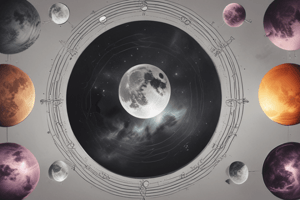Podcast
Questions and Answers
What is the meaning of 'Axis'?
What is the meaning of 'Axis'?
An imaginary line that passes through Earth's center and the North and South poles, about which Earth rotates.
What does 'Revolution' refer to?
What does 'Revolution' refer to?
The movement of an object around another object.
What are the 'Phases of the Moon'?
What are the 'Phases of the Moon'?
One of the different apparent shapes of the moon as seen from Earth, caused by the moon's angle to the Earth and the Sun.
Define 'Satellite'.
Define 'Satellite'.
What is 'Rotation'?
What is 'Rotation'?
What occurs during a 'Solar Eclipse'?
What occurs during a 'Solar Eclipse'?
What happens during a 'Lunar Eclipse'?
What happens during a 'Lunar Eclipse'?
What is a 'Tide'?
What is a 'Tide'?
Define 'Spring Tide'.
Define 'Spring Tide'.
Define 'Neap Tide'.
Define 'Neap Tide'.
Why does the moon appear to change shape during the course of a month?
Why does the moon appear to change shape during the course of a month?
How can you tell if the moon is waxing or waning?
How can you tell if the moon is waxing or waning?
Why do tides occur?
Why do tides occur?
At which phase of the moon do solar eclipses occur?
At which phase of the moon do solar eclipses occur?
At which phase of the moon do lunar eclipses occur?
At which phase of the moon do lunar eclipses occur?
Why isn't there a solar eclipse or lunar eclipse each month?
Why isn't there a solar eclipse or lunar eclipse each month?
What is a 'New Moon'?
What is a 'New Moon'?
What is 'Waxing Crescent'?
What is 'Waxing Crescent'?
What is 'First Quarter'?
What is 'First Quarter'?
What is 'Waxing Gibbous'?
What is 'Waxing Gibbous'?
What is 'Full Moon'?
What is 'Full Moon'?
What is 'Waning Gibbous'?
What is 'Waning Gibbous'?
What is 'Third Quarter'?
What is 'Third Quarter'?
What is 'Waning Crescent'?
What is 'Waning Crescent'?
Flashcards are hidden until you start studying
Study Notes
Key Terms and Definitions
- Axis: Imaginary line through Earth's center connecting North and South poles; defines Earth's rotation.
- Revolution: Movement of an object around another object in space.
- Phases of the Moon: Distinct shapes of the moon as observed from Earth; influenced by the moon's position relative to Earth and the Sun.
- Satellite: An object that revolves around another object in space, e.g., the moon around Earth.
- Rotation: The spinning motion of a planet on its axis.
Eclipses
- Solar Eclipse: Occurs when the moon blocks sunlight to Earth, aligning directly between the sun and Earth.
- Lunar Eclipse: Happens when Earth blocks sunlight from reaching the moon, placing Earth between the sun and the moon.
- New Moon Phase: Solar eclipses take place; the moon is positioned between the sun and Earth.
- Full Moon Phase: Lunar eclipses occur; the arrangement involves the sun, Earth, and moon.
Phases of the Moon
- New Moon: First phase; the moon's surface facing Earth is dark, no visible light.
- Waxing Crescent: A small sliver of the moon is visible, illuminated on the right side.
- First Quarter: Half of the moon's disk is visible; the right side is lit.
- Waxing Gibbous: About three-quarters of the moon is lit, with the right side illuminated.
- Full Moon: Entire disk is illuminated because Earth is between the moon and the sun.
- Waning Gibbous: Roughly three-quarters of the moon is visible, but the left side is illuminated.
- Third Quarter: The left half of the moon's disk is lit, showing one-half visibility.
- Waning Crescent: Only a small sliver of the moon is visible, illuminated on the left side.
Tides
- Tides: Periodic rise and fall of ocean water levels caused by the moon's gravitational pull.
- Spring Tide: Greatest difference between high and low tides, occurring during Full and New Moons.
- Neap Tide: Least difference between consecutive low and high tides, occurring during First and Third Quarters.
Understanding Lunar Cycles
- Waxing vs. Waning: Waxing refers to the moon appearing to grow (from New Moon to Full Moon); waning indicates shrinking (from Full Moon to New Moon).
- Eclipse Frequency: Eclipses do not occur monthly due to the moon's orbital tilt of 5 degrees relative to Earth's orbit; eclipses typically happen every six months.
Studying That Suits You
Use AI to generate personalized quizzes and flashcards to suit your learning preferences.




